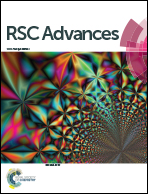Hypoxia-responsive drug–drug conjugated nanoparticles for breast cancer synergistic therapy†
Abstract
In order to eliminate tumors, it is necessary to kill differentiated cancer cells, cancer stem cells (CSCs) and the “vascular niche” synergistically. Although nanoparticles (NPs) have been used to deliver drugs to the action sites, inert materials with high toxicity may reduce the drug loading content and cause side-effects to kidneys and other organs in the course of degradation and excretion. Here, we report hypoxia-responsive drug–drug conjugated NPs to deliver three drugs to kill differentiated cancer cells, CSCs and the “vascular niche” synergistically, which could selectively release the drugs to treat cells in hypoxic tumors. For this purpose, an azobenzene (AZO) bond imparting hypoxia sensitivity and specificity as a crosslinker conjugated hydrophobic combretastatin A-4 (CA4) with hydrophilic irinotecan (IR) to form IR–AZO–CA4 amphiphilic molecules. These molecules self-assembled into NPs, which could encapsulate hydrophobic anti-CSCs drug cyclopamine (CP). The drug–drug conjugated NPs had high drug loading content. As expected, the AZO linker could be broken under hypoxia conditions and the NPs were disassembled to release drugs quickly. Confocal laser scanning microscopy (CLSM) results indicated that the IR–AZO–CA4/CP NPs could enhance the cellular uptake of drugs and the permeability of drugs to the inner of CSCs, beneficial for tumor therapy. Furthermore, the IR–AZO–CA4/CP NPs could inhibit the migration, invasion and mammosphere formation capacity of CSCs. More importantly, only IR–AZO–CA4/CP NPs could simultaneously inhibit differentiated cancer cells, CSCs and endothelial cells without interference on the cell under a normoxic environment. The present study suggests that the IR–AZO–CA4/CP NPs provide a promising therapeutic approach for anticancer treatment.


 Please wait while we load your content...
Please wait while we load your content...